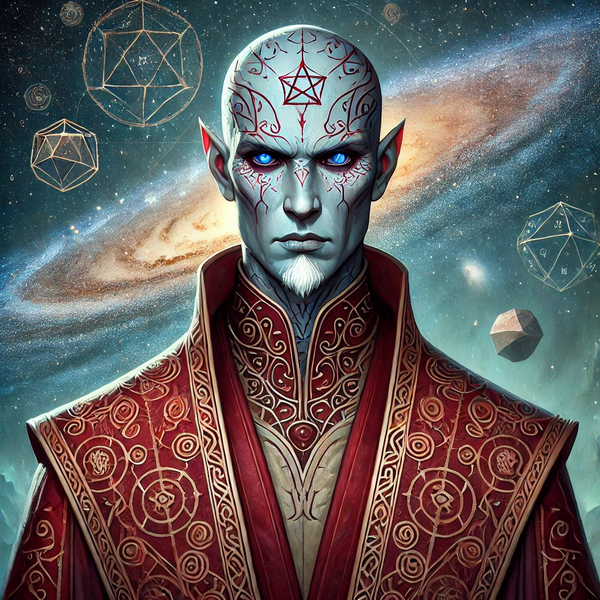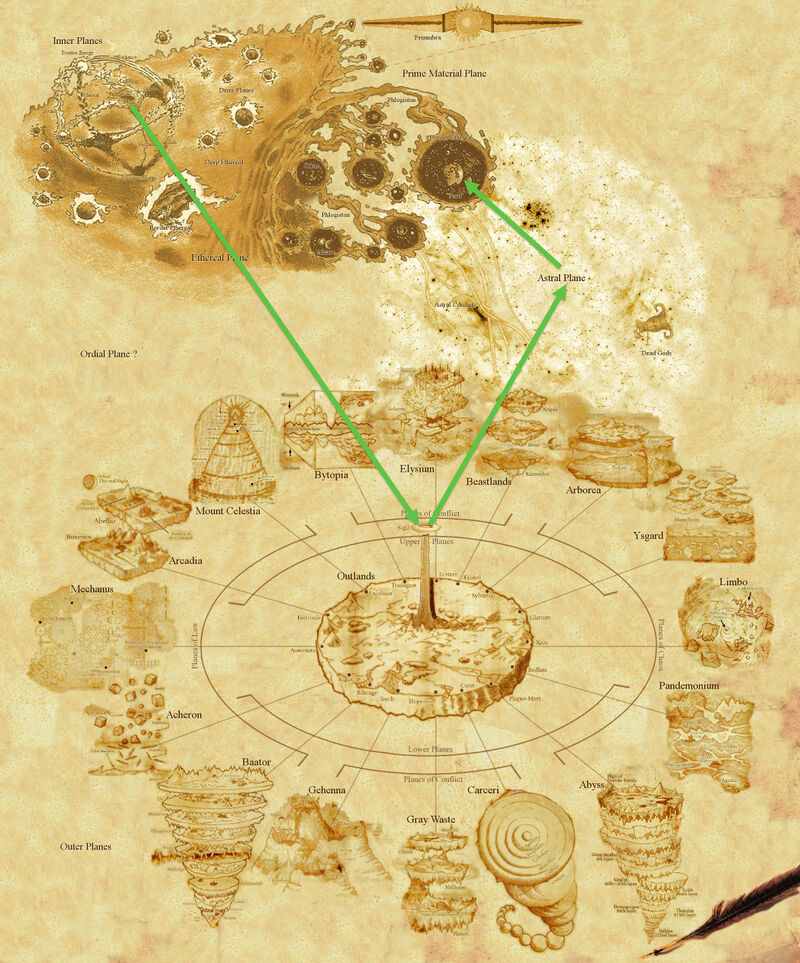Session 10b: There's No Place Like Faerûn

Summary


The party returned from their astral journey, awakening in Galdren's estate after half a tenday of sleep. Most experienced a brief vision of starry expanse before returning to their bodies, but Octavius had a more dramatic encounter. He found himself trapped in a crystal orb in the Astral Plane, confronted by the colossal figure of Tharos, who warned him away from Thay and the Grove of Stars before attempting to crush him.
Upon awakening, the group was greeted by Neribion, Galdren's apprentice, who reacted with curiosity to their new companions - Unit 137, Smokescale, and Uchu. Galdren soon joined them, expressing renewed hope upon seeing the grand sensory stone they had acquired. He rewarded the party with gold and a Weave-attuned sextant, announcing plans to study the stone in order to store the memories of a deceased person invaluable to the cause, inviting Dr. Itero's assistance. He also promised Glenn that the Wychlaran witches would answer his call to heal him of his affliction soon.
As the session progressed, Cedani performed an elaborate ritual in the estate's garden to summon Sugarplum, a frost pixie sent by her patron. Sugarplum arrived in a swirl of icy wind, offering her magical aid for their quest. However, she also demonstrated her mischievous nature by tricking Glenn into "giving her his name," rendering him unable to speak it.
The session concluded with the party settling in for the night, poised on the brink of new challenges in their quest to reshape Thay's fate. Galdren's warning about the need for secrecy and the looming threat of divination magic may shape future sessions to come.
XP Award
- 1000 XP for retrieving the Grand Sensory Stone and completing Chapter 1
- 100 XP for feeding Kai a carrot
- 100 XP for finding your identities with the factions
- Total: 1200 XP
- Current XP: 10413 XP -> 11613 XP (Level 5)
- (Required for next level: 14000 XP)
Things That Happened
A Clash of Prophets
- Date: 7th of Tarsakh (The Claw of the Storms, April), 1372 DR, late evening
- Most party members saw a silver starry expanse around them briefly, with their astral form flowing through a silver conduit in freefall, then another burst of white light.
- At first they could not move, still wrapped in Mulhorandi linen, until it melted into water right as their equipment reappeared on their bodies.
- Several cats yelped in alarm, having used the party as cat beds, running for the kitchens. An older gray cat took his time, stretching with an annoyed expression.
- Octavius, however, was still wrapped in linen, and saw something different.
- Octavius found himself suspended in a massive crystal orb in the Astral Plane.
- Tharos appeared as a colossal figure, a blue-eyed ashen-skinned elf with a white goatee, his cloak blending with the starry backdrop.
- Tharos, surprised that someone breached his Meditation Realm, picked up the orb containing Octavius.
- He recognized Octavius as "the owl" that had vanished from his sight. Briefly, he looked afraid.
- Tharos warned Octavius not to enter Thay or The Grove of Stars.
- He claimed the Monolith was his by right of conquest.
- Tharos mentioned a vision of Octavius consumed by flames at the Monolith's foot.
- He threatened to "finish what Vezim started" and reached out to crush Octavius.
- Octavius slipped away, pulled by a cosmic force out of the orb.
- Tharos shouted as his massive hands barely missed Octavius.
- Octavius awoke in his body.
Awakening
- Neribion, Galdren's apprentice, greeted the party upon their awakening.
- He informed them they'd been asleep for half a tenday and left to fetch Galdren.
- The party removed Uchu, Unit 137, and Smokescale from the Bag of Holding.
- Neribion returned, announcing Galdren's imminent arrival.
- He reacted to Unit 137 with fascination, expressing that he thought he could hear the modron's cogitation. Unit 137 took it as a compliment.
- Neribion initially tensed at Smokescale's presence, demanding assurance of safety and an order for him to not harm anything on the grounds.
- Neribion welcomed Uchu in Japanese using his necklace, expressing interest in his telepathy.
- He mistook the Mimir for another fiend, showing hidden excitement upon learning its nature as a source of knowledge.
- Neribion offered to clean the dust-covered flying carpet, taking it and the Mimir to the gardens. Midwinter gifts came early this year.
Galdren's Hope
- Galdren Murendar descended the stairs, looking weary but focused.
- He greeted the party, acknowledging their success and new companions.
- Galdren informed them that their former companions had departed.
- The party showed him the grand sensory stone, which he placed on an orb cradle.
- He expressed that this discovery "changes everything" and rekindled hope.
- Galdren magically unlocked a chest containing 2000 gold pieces as a reward.
- He gave Dr. Itero a Weave-attuned sextant for measuring leylines.
- Galdren announced plans to study the stone with Neribion and invited Dr. Itero's assistance. Their aim is to modify a spell to allow the capture of a deceased person's memories into it, as an ally to their cause died with valuable information. Neribion handed him tomes and scattered notes based on their current research.
- He estimated the work would take four tendays, possibly until Mirtul or Kythorn.
- Glenn was informed that the Wychlaran might soon provide insight into his affliction. He should hear back in a few days.
- Galdren emphasized the importance of their work in reshaping Thay's fate.
- Neribion was spotted joy-riding the flying carpet outside a window.
- He requested the party continue sleeping in the room to shield against divination.
Galdren's Notes
Fragment 1: On the Amnesia of the Departed
[...] the curious phenomenon of post-mortem memory loss, as observed through rigorous study of souls in various planar realms. The savant must needs comprehend that the transition from mortal coil to afterlife is not merely a journey of the flesh, but a profound transformation of the very essence.
Myriad accounts from the celestial plains and the infernal pits of the Nine Hells corroborate a most perplexing truth: the newly arrived souls oft lack clear recollection of their mortal existence. The Proxies of Kelemvor, in their vigilant record-keeping, note that but one in a score of fresh souls can recount with any clarity the circumstances of their demise, let alone the breadth of their mortal days.
Sages of Thesk posit that this amnesia is not a flaw, but a crucial feature of the transition. They argue, in their grimoire "Veils of Lethe," that the shedding of mortal memories serves as a balm, allowing souls to more readily accept their new existence. Yet, this theory fails to account for the selective nature of the forgetting, as many souls retain fragments of their past, like islands of recollection in a sea of oblivion.
More controversial still are the whispers from the Shadowfell, where the Shadar-kai speak of a "Mnemonic Tithe" extracted by unknown entities during a soul's passage. They claim this tithe serves as payment for safe transit through the Astral Plane, though the purpose and recipient of such a toll remain shrouded in mystery.
The true nature of this post-mortem amnesia continues to elude even the most erudite of planar scholars, leaving us to ponder: Is it a mercy? A metaphysical necessity? Or perhaps, a clue to some grander design in the architecture of the multiverse itself? [...]
Fragment 2: The Veil of Resurrection
[...] the enigmatic lacuna in the memories of those rare individuals who have tasted death, only to be pulled back to the realm of the living. The process of resurrection, far from being a simple reversal of expiration, appears to draw a gossamer veil across the experiences of the afterlife.
The Revenant Philosophers of Myth Drannor have documented countless cases of resurrected individuals, from common folk to legendary heroes, who find themselves unable to recount their sojourn beyond the veil. In the tome "Echoes of the Interim," they posit that this amnesia serves as a cosmic safeguard, preventing the secrets of the afterlife from bleeding into the mortal realm.
Yet, this theory is not without its detractors. The Thayan Soulwrights argue in their "Codex Vitae et Mortis" that the memories of the afterlife are indeed retained, but are simply inaccessible to the conscious mind of the resurrected. They point to cases of individuals experiencing vivid dreams or exhibiting inexplicable knowledge post-resurrection as evidence of submerged afterlife memories.
More esoteric still are the claims of the Seelie Court's Dream Weavers, who insist that the memories of the afterlife are not lost, but transmuted. They propose that these experiences are encoded into the very essence of the resurrected, influencing their behaviors and instincts in subtle, often imperceptible ways.
This amnestic phenomenon raises profound questions about the nature of consciousness and the soul's journey. Is it a merciful obliteration of potentially traumatic experiences? A necessary reset to maintain the boundary between life and death? Or perhaps, a tantalizing clue to the true nature of existence, forever just beyond our grasp? [...]
Fragment 3: The Astral Mnemonic Diaspora
[...] the curious phenomenon of memory cores separating from the soul during its traverse of the Astral Plane, whether journeying from life to death or in the rare instance of resurrection. This process, termed the "Mnemonic Diaspora" by the sages of Candlekeep, presents a conundrum that has puzzled theurgists and philosophers alike for eons.
Beings known as the githyanki, in their endless patrols of the Astral, report witnessing cascades of luminous motes dispersing from traveling souls, each mote seemingly imbued with fragments of memory and experience. These motes, they claim, linger in the timeless expanse of the Astral, forming eddies and currents of pure recollection.
Several theories attempt to explicate this phenomenon. Thaumaturgists propose that the shedding of memories is a necessary "defragmentation" of the soul, optimizing it for its new state of existence. Conversely, spiritspeakers from the Far East argue that this dispersal is merely a side effect of the soul's passage through the chaotic medium of the Astral, with no greater purpose than the arbitrary whims of an uncaring multiverse.
Perhaps most intriguing is the hypothesis put forth by the Astral Diviners of Selûne. They posit that the memory cores are not truly separated from the soul, but rather expanded across the Astral Plane, creating a vast, intangible network of experiences. This network, they claim, forms the very fabric of planar knowledge and may be the source of all intuition and déjà vu experienced by mortal beings.
The implications of this Mnemonic Diaspora are profound. If memories are indeed shed and left adrift in the Astral, what becomes of them? Can they be reclaimed? And what of those intrepid or unfortunate souls who find themselves stranded in the Astral? Do they risk losing themselves piece by piece to the silvery void? [...]
Fragment 4: On the Thaumaturgical Interrogation of Cadavers
[...] the arcane practice of bestowing temporary semblance of life upon a deceased form, not to reanimate the flesh, but to recall the echoes of memory that once dwelt therein. This ritual, shrouded in controversy and misunderstanding, is neither a true resurrection nor a mere puppetry of the corpse.
The crux of this necromancy lies in its ability to recall not the soul, but the memory core of the departed. As elucidated in the grimoire "Whispers of the Passed" by the necromancer Velsharoon, the ritual creates a momentary bridge between the mortal realm and the dispersed mnemonic essences in the Astral Plane.
This bridge, ephemeral and fragile, allows for the temporary reintegration of specific memory clusters with the deceased's physical form. It is crucial to note that this does not recall the soul itself, which may have long since traveled to its final rest. Instead, it accesses a kind of echo, a remnant imprint of the individual's experiences and knowledge.
The ritual's efficacy is influenced by numerous factors, chief among them the state of preservation of the corpse and the strength of the memory core's imprint. Fresher cadavers, or those of individuals who lived lives of great impact, tend to yield more coherent and detailed responses.
It is imperative to understand that the consciousness summoned by this ritual is but a shadow, a fragment of what once was. It possesses neither the full awareness nor the complete personality of the deceased. Rather, it is a limited construct, capable only of responding to direct inquiries with information it possessed in life.
The ethical implications of this practice remain a subject of fierce debate among mages and clerics alike. Some view it as a respectful means of gaining crucial information from the departed, while others decry it as a violation of the natural order and the soul's right to peaceful transition. [...]
Fragment 5: On the Minutiae of Mnemonic Invocation
[...] the intricate components that comprise the thaumaturgical formula for mnemonic invocation, colloquially referred to as the cadaveric interrogation ritual. It behooves the aspiring theurgist to comprehend that the inscriptions found in grimoires and spellbooks are but ciphers, encoding the true nature of the arcane workings.
The fundamental structure of the ritual consists of three primary elements: the Astral Tether, the Mnemonic Beacon, and the Corporeal Anchor. Each of these must be precisely calibrated to achieve the desired effect.
The Astral Tether serves as the conduit between the material plane and the Astral, where the dispersed memory cores reside. Its efficacy is heavily influenced by the caster's understanding of planar dynamics and their ability to visualize the ethereal pathways that connect the realms.
The Mnemonic Beacon is perhaps the most crucial and delicate component. It must be attuned to the specific resonance of the deceased's memory core, a task that requires both precise arcane calculations and a certain degree of intuitive adjustment. The beacon's strength determines the clarity and coherence of the invoked memories.
Lastly, the Corporeal Anchor binds the recalled memories to the physical remains, allowing for the temporary reanimation necessary for communication. The anchor's stability is directly proportional to the state of preservation of the cadaver and the skill of the caster in establishing the mystical connection.
It is imperative to note that the specific formulae for these components are not universal constants, but rather guidelines that must be adapted to each individual case. Factors such as the time elapsed since death, the manner of demise, and even the personal history of the deceased can all influence the precise calibration required.
Moreover, the caster must be prepared to make split-second adjustments during the ritual itself, as the interaction between the components can produce unpredictable harmonic resonances that must be balanced in real-time.
The Thayan Arbiter of Esoterica, in her seminal work "Veiled Whispers and Spectral Echoes," emphasizes the importance of experimentation and inference in mastering this art. She posits that true understanding comes not from rote memorization of formulae, but from a deep, intuitive grasp of the underlying principles and the ability to adapt them to myriad circumstances.
In conclusion, the aspiring practitioner must approach this ritual with both rigorous study and a willingness to embrace the unpredictable nature of mnemonic invocation. Only through careful observation, meticulous record-keeping, and daring experimentation can one hope to unravel the full potential of this most enigmatic of thaumaturgical arts. [...]
The Summoning
- Cedani performed an elaborate ritual to summon Sugarplum in the estate's garden.
- The ritual involved a circular pattern, runic stones, and a silver bell.
- Cedani recited poems in the Feywild tongue, causing frost to shimmer and dance.
- Sugarplum, a pixie with blue-tinged skin and frost-like wings, appeared in a swirl of icy wind.
- She greeted Cedani with a rhyme, introducing herself as Cedani's patron-sent friend.
- Sugarplum expressed wonder at the estate's misplaced location in a cold forest.
- She offered her magical assistance and charm to help with their quest.
- Sugarplum then tricked Glenn into "giving her his name", rendering him unable to speak it.
- She has a very evil cackle.
- The session came to a close as the party settled in for the night.
Maps

NPCs Encountered (or mentioned)
- Smoothshell, the Tortle Cipher
- Lexor-6, the Formian Guvner
- Kura, the Witch on a Broom
- Yara Thornfoot, the Chatty Taker
- Unknown, the Living Armor
- Boppel, the High-Up Man
- Grax, the Blue Slaad in a Trenchcoat
Memes
DM Thoughts
- Missed connections are soul-shattering to players.